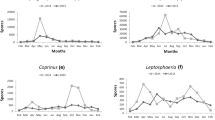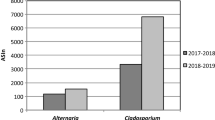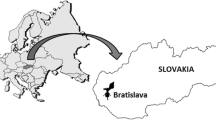Abstract
The present study sought to examine Coprinus and Ganoderma airborne spore counts, analysing seasonal variations, the influence of meteorological variables and intraday behaviour with a view to charting the aerobiological dynamics of both genera in Havana (Cuba) during a 2-year period (November 2010–October 2012). A Hirst-type volumetric air sampler was used as sampling methodology. The spores registered in the air were identified and counted following the model proposed by the Spanish Aerobiological Network based on two longitudinal transects along the slides. Coprinus spores outnumbered those of the Ganoderma (28,468 annual total spores vs. 1,921 spores). Moreover, both genera were recorded in the atmosphere on a large number of days over the two-year study period, with daily maximum concentrations in the rainy months. The daily maximum value for Coprinus was 880 spores/m3 (30 September 2011), whereas for Ganoderma 44 spores/m3 (4 September 2011). The analysis of the Spearman correlation coefficient showed a significant positive correlation of the airborne Coprinus and Ganoderma spores with the temperature, relative humidity and rainfall, whereas the degree of association is negative with the wind speed. Regarding the intraday behaviour, both basidiospores were more abundant in the atmosphere during the night, with a maximum peak at 5–6 a.m.



Similar content being viewed by others
References
Aira, M. J., Rodríguez-Rajo, F. J., Castro, M., & Jato, V. (2009). Characterization of Coprinus spores in the NW of the Iberian Peninsula. Identification and count in aerobiological samples. Cryptogamie. Mycologie, 30(1), 57–66.
Aira, M. J., Rodríguez-Rajo, F. J., Fernández-González, M., Seijo, C., Elvira-Rendueles, B., Abreu, I., et al. (2012b). Spatial and temporal distribution of Alternaria spores in the Iberian Peninsula atmosphere, and meteorological relationships: 1993–2009. International Journal of Biometeorology. doi:10.1007/s00484-012-0550-x.
Aira, M. J., Rodríguez-Rajo, J., Fernández-González, M., Seijo, C., Elvira-Rendueles, B., Gutiérrez-Bustillo, M., et al. (2012a). Cladosporium airborne spore incidence in the environmental quality of the Iberian Peninsula. Grana, 51(4), 293–304.
Almaguer, M., Rojas-Flores, T., Dobal-Amador, V., Batista-Mainegra, A., Rives-Rodríguez, N., Aira, M. J., et al. (2012). Aerobiological dynamics of potentially pathogenic fungi in a rice agroecosystem in La Havana. Cuba. Aerobiologia, 28, 177–183.
Bhosle, S., Ranadive, K., Bapat, G., Garad, S., Deshpande, G., & Vaidya, J. (2010). Taxonomy and diversity of Ganoderma from the Western parts of Maharashtra (India). Mycosphere, 1(3), 249–262.
Brander, K. A., & Pichler, W. J. (1999). Isolation of Basidiomycete allergens. International Archives of Allergy and Immunology, 118(2–4), 302–303.
Bush, R. K., & Portnoy, J. M. (2001). The role and abatement of fungal allergens in allergic diseases. Journal of Allergy and Clinical Immunology, 107(3), 430–440.
Cabarroi, M., Maldonado, S., & del Castillo, L. (2008). Hongos del Jardín Botánico Nacional de Cuba. I. Basidiomycota. Revista del Jardín Botánico de Cuba, 29, 161–169.
Calderón, C., Lacey, J., McCartney, H. A., & Rosas, I. (1995). Seasonal and diurnal variation of airborne Basidiomycete spore concentrations in Mexico City. Grana, 34, 260–268.
Craig, R. L., & Levetin, E. (2000). Multi-year study of Ganoderma aerobiology. Aerobiologia, 16, 75–80.
Díaz, A., Fabré, D. A., Coutin, G., & González, T. (2010). La sensibilización a hongos ambientales y su relación con enfermedades atópicas en escolares. Revista Cubana de Medicina General Integral, 26(4), 647–655.
Galán, C., Cariñanos, P., Alcázar, P., & Domínguez, E. (2007). Manual de Calidad y Gestión de la Red Española de Aerobiología. Córdoba: Servicio de Publicaciones de la Universidad de Córdoba.
Grinn-Gofroń, A., & Strzelczak, A. (2011). The effects of meteorological factors on the occurrence of Ganoderma sp. spores in the air. International Journal of Biometeorology, 55(2), 235–241.
Hasnain, S. M., Akhter, T., & Waqar, M. A. (2012). Airborne and allergenic fungal spores of the Karachi environment and their correlation with meteorological factors. Journal of Environmental Monitoring, 14, 1006–1013.
Hasnain, S. M., Al-Frayth, A., Khatija, F., & Al-Sedairy, S. (2004). Airborne Ganoderma basidiospores in a country with desert environment. Grana, 43, 111–115.
Hasnain, S. M., & Khatija, F. (2005). Prevalence of airborne basidiospores in three coastal cities of Saudi Arabia. Aerobiologia, 21, 139–145.
Helbling, A., Brander, K. A., Horner, W. E., & Lehrer, S. B. (2002). Allergy to Basidiomycetes. In M. Breitenbach, R. Crameri, & S. B. Lehrer (Eds.), Fungal allergy and pathogenicity (pp. 28–47). Basel: Karger.
Ho, H.-M., Rao, C. Y., Hsu, H.-H., Chiu, Y.-H., Liu, Ch.-M., & Chao, H. J. (2005). Characteristics and determinants of ambient fungal spores in Hualien. Taiwan. Atmospheric Environment, 39, 5839–5850.
Jothish, P. S., & Nayar, T. S. (2004). Airborne fungal spores in a sawmill environment in Palakkad District, Kerala, India. Aerobiologia, 20, 75–81.
Kasprzyk, I., Grinn-Gofroń, A., Strzelczak, A., & Wolski, T. (2011). Hourly predictive artificial neural network and multivariate regression trees models of Ganoderma spore concentrations in Rzeszów and Szczecin (Poland). Science of the Total Environment, 409, 949–956.
Lehrer, S. B., & Hughes, J. M. (1994). Prevalence of Basidiomycete allergy in the USA and Europe and its relationship to allergic respiratory symptoms. Allergy, 49(6), 460–465.
Levetin, E., & Horner, E. (2002). Fungal aerobiology: Exposure and measurement. Fungal Allergy and Pathogenicity, 81, 10–27.
Mallo, C. A., Nitiu, D. S., & Gardella, M. C. (2011). Airborne fungal spore content in the atmosphere of the city of La Plata, Argentina. Aerobiologia, 27, 77–84.
Minter, D. W., Rodríguez, M., & Mena, J. (2001). Fungi of the Caribbean. An annotated checklist. London: PDMS Publishing.
Mitakakis, T. Z., & Guest, D. I. (2001). A fungal spore calendar for the atmosphere of Melbourne, Australia, for the year 1993. Aerobiologia, 17, 171–176.
Morales, F. J., Gonzalez-Minero, M., Carrasco, V. M., & Ogalla, P. (2006). Airborne basidiospores in the atmosphere of Seville (South Spain). Aerobiologia, 22, 127–134.
Nasser, S. M., & Pulimood, T. B. (2009). Allergens and thunderstorm asthma. Current Allergy and Asthma Reports, 9(5), 384–390.
Newhouse, C. P., & Levetin, E. (2004). Correlation of environmental factors with asthma and rhinitis symptoms in Tulsa, Oklahoma. Annals of Allergy, Asthma & Immunology, 92, 356–366.
Nilsson, S., & Persson, S. (1981). Tree pollen spectra in the Stockholm region (Sweden), 1973–1980. Grana, 20, 179–182.
Okten, S. S., Asan, A., Tungan, Y., & Ture, M. (2005). Airborne fungal concentrations in East Patch of Edrine city (Turkey) in autumn using two sampling methods. Trakya University Journal of Science, 6(1), 97–106.
Oliveira, M., Ribeiro, H., & Abreu, I. (2005). Annual variation of fungal spores in atmosphere of Porto: 2003. Annals of Agricultural and Environmental Medicine, 12, 309–315.
Pérez, J. M., & Vilaró, M. (2000). Riqueza micológica en un sitio natural del Jardín Botánico Nacional. Revista del Jardín Botánico Nacional Universidad de la Havana, 21(1), 133–137.
Quintero, E., Rivera-Mariani, F., & Bolaños-Rosero, B. (2010). Analysis of environmental factors and their effects on fungal esporas in the atmosphere of a tropical urban area (San Juan, Puerto Rico). Aerobiologia, 26(2), 113–124.
Rivera-Mariani, F. E., & Bolaños-Rosero, B. (2012). Allergenicity of airborne basidiospores and ascospores: Need for further studies. Aerobiologia, 28, 83–97.
Rivera-Mariani, F. E., Nazario-Jimenez, S., López-Malpica, F., & Bolaños-Rosero, B. (2011a). Skin test reactivity of allergic subjects to basidiomycetes crude extracts in a tropical environment. Medical Mycology, 49(8), 887–891.
Rivera-Mariani, F. E., Nazario-Jiménez, S., López-Malpica, F., & Bolaños-Rosero, B. (2011b). Sensitization to airborne ascospores, basidiospores, and fungal fragments in allergic rhinitis and asthmatic subjects in San Juan, Puerto Rico. International Archives of Allergy Immunology, 155(4), 322–334.
Semik-Orzech, A., & Barczyk, A. (2008). The influence of sensitivity to fungal allergens on the development and course of allergic diseases of the respiratory tract. Pneumonologia i Alergologia Polska, 76(1), 29–36.
Singh, A. B., Gupta, S. K., Pereira, B. M. J., & Prakash, D. (1995). Sensitization to Ganoderma lucidum in patients with respiratory allergy in India. Clinical and Experimental Allergy, 25, 440–447.
Stępalska, D., & Wołek, J. (2009). Intradiurnal periodicity of fungal spore concentrations (Alternaria, Botrytis, Cladosporium, Didymella, Ganoderma) in Cracow, Poland. Aerobiologia, 25, 333–340.
Taylor, P. E., & Jonsson, H. (2004). Thunderstorm asthma. Current Allergy Asthma Reports, 4(5), 409–413.
Venero, S. J., Varona, P., Fabret, D., Suárez, R., Bonet, M., & Molina, E. (2009). Asma bronquial y rinitis en escolares de ciudad de La Havana (2001 a 2002). Revista Cubana de Higiene y Epidemiología, 47(1), 1–5.
Webster, J., & Webber, R. (2007). Introduction to fungi. Cambridge: Cambridge University.
Author information
Authors and Affiliations
Corresponding author
Rights and permissions
About this article
Cite this article
Almaguer, M., Rojas-Flores, T.I., Rodríguez-Rajo, F.J. et al. Airborne basidiospores of Coprinus and Ganoderma in a Caribbean region. Aerobiologia 30, 197–204 (2014). https://doi.org/10.1007/s10453-013-9318-y
Received:
Accepted:
Published:
Issue Date:
DOI: https://doi.org/10.1007/s10453-013-9318-y




